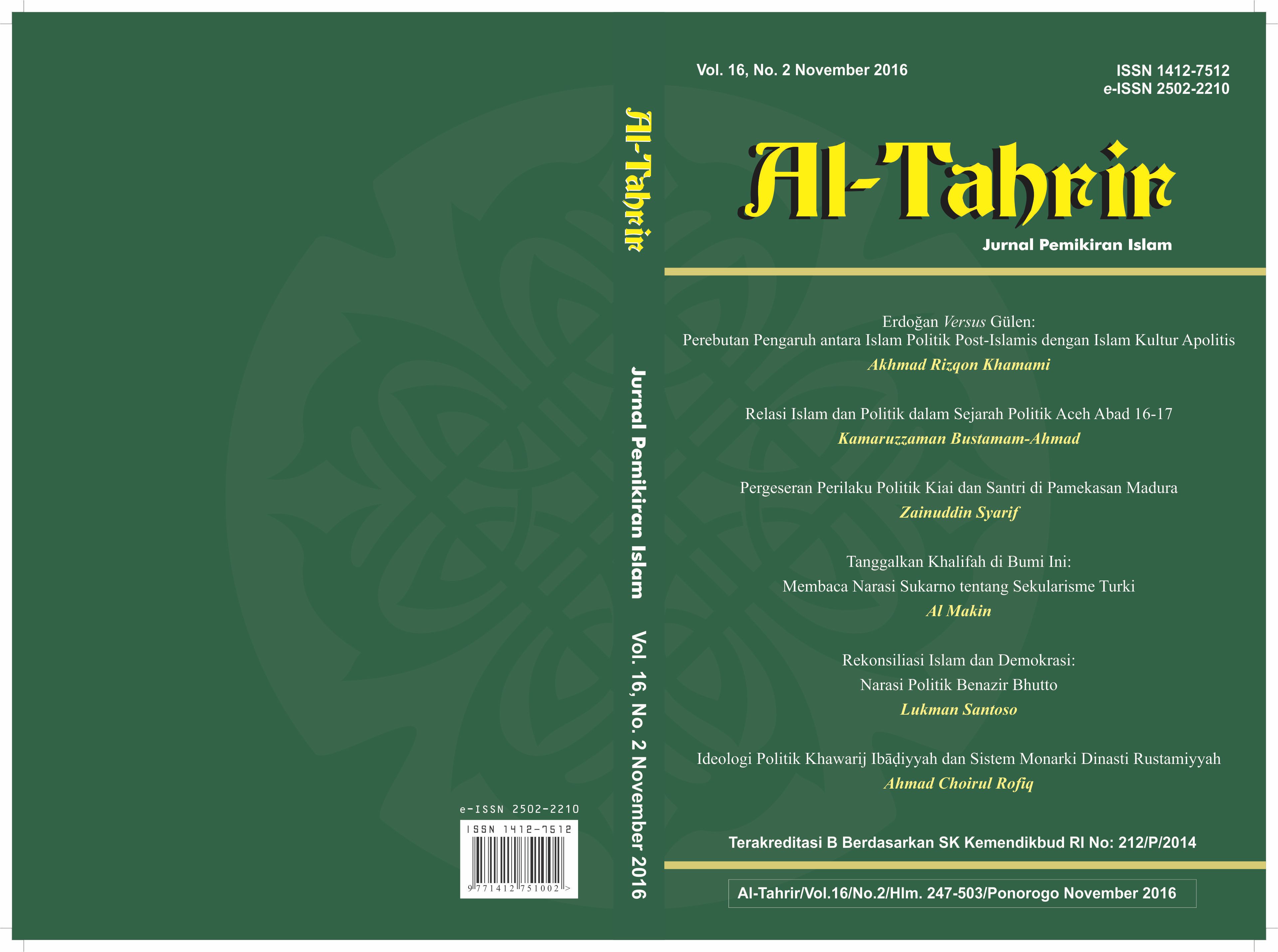Tafsi>r al-Qummi> dan Politik: Telaah atas Kecenderungan Tasyayyu’ dalam Penafsiran Surat al-Baqarah
DOI:
https://doi.org/10.21154/al-tahrir.v16i2.483Keywords:
al-Qummi, tasyayyu’, takwil, political interpretation, ima>mahAbstract
Abstract: Nearly All muslims agree on the unity of the Qur’an. Nevertheless, this unity could not guarantee uniformity of interpretation. The differences on background of readers and interpreters may result in different interpretation. Tafsi>r al-Qummi>, as one of Shia Imamate’s books of exegesis which appears in certain mileu might reflect a tendency to take political attitude such as tashayyu’ or to glorify Ali and his descendants. Such a tendency can be viewed through comparing the method of takwil used by al-Qummi> and Tafsir Kementerian Agama in understanding particular verses affirming the prominence of Ali and his descendants. Takwil is conducted through putting verses with general meaning into another meaning that affirms the excellency of Ali and his descendants or putting their opponents as victims. This type of takwil could be traced back on the mileu in which al-Qummi> lived and interacted with the opponent schools at that time. This research shows that interpretation is mere expression of competition among readers in order to obtain superiority among others.
الملخص: المسلمون علي وشك الإتÙاق بوØدة القران. ولكن لا يضمن هذا علي ÙˆØدة تÙسيره. إختلا٠التÙسير باختلا٠موق٠خلÙية المÙسرين له. علي سبيل المثال، التÙسير القمي يعتبر من التÙاسير القراني الصادر عن البيئة والظرو٠الذي يعكس الميل إلي التشيع أي التمجيد بموق٠علي رضي الله عنه وذريته. يمكن رؤية هذا الإتجاه التشيع من خلال الأساليب المستخدمة ÙÙŠ تأويل بعض الأيات القرانية Øيث أكد علي عظمة علي رضي الله عنه وذريته. بالدراسة المقارنة بين التÙسير القمي وتÙسير وزارة الشؤن الدينية (kementerian agama)ØŒ ظهرأنه يتم التأويل ÙÙŠ التÙسير القمي بوضع الأيات ذات المعني العامة إلي معني المشير إلي عظمة علي رضي الله عنه وذريته. أوالعكس، يؤلها إلي المعني الخاص بوضع المعارضين لعلÙÙŠ رضي الله عنه وذريته كضØية. يمكن أن يعزو هذا النوع من نمط التÙسير إلي البيئة التي يعيش Ùيه القمي ويتÙاعل بالمذاهب الماعكس ÙÙŠ ذلك العصر. ÙˆÙŠÙˆØ¶Ø Ù‡Ø°Ø§ البØØ« أيضا، أن التÙسيرات هي مجرد تعبيرات Øول واقع المناÙسة بين القارء للØصول على ميزة تجاه المجموعات الأخرى.
Abstrak: Umat Islam hampir sepakat akan kesatuan al-Qur’an. Namun demikian, kesatuan ini tidak menjamin adanya kesatuan tafsir. Perbedaan latar belakang penafsir menyebabkan perbedaan penafsiran. Tafsi>r al-Qummi> sebagai sebuah tafsir Syi’ah Imamiyyah yang muncul dalam miliu tertentu merefleksikan suatu kecenderungan politik tashayyu’ atau sikap mengagungkan Ali dan keturunannya. Kecenderungan tashayyu’ ini dapat dilihat melalui metode takwil yang ia gunakan untuk memahami ayat-ayat guna menegaskan keagungan ”˜Ali dan keturunannya. Hal ini diketahui dengan studi komparatif terhadap Tafsir Kementerian Agama. Takwilnya dilakukan dengan meletakkan ayat-ayat yang bermakna umum ke dalam makna yang menegaskan keagungan Ali dan keturunannya atau sebaliknya ditakwil ke dalam makna yang menempatkan lawan-lawan Ali dan keturunannya sebagai korban. Pola takwil semacam ini dapat dilacak ke dalam lingkungan al-Qummi dimana ia hidup dan berinteraksi dengan lawan-lawan madzhabnya pada masa itu. Penelitian ini juga menunjukkan bahwa interpretasi hanyalah semata-mata expressi tentang realitas kompetisi antara pembaca untuk memperoleh keunggulan dibanding kelompok lain.
Downloads
Downloads
Published
Issue
Section
License
Please find the rights and licenses in Al-Tahrir. By submitting the article/manuscript of the article, the author(s) agree with this policy. No specific document sign-off is required.
1. License
The non-commercial use of the article will be governed by the Creative Commons Attribution license as currently displayed on Creative Commons Attribution-NonCommercial 4.0 International License.
2. Author(s)' Warranties
The author warrants that the article is original, written by stated author(s), has not been published before, contains no unlawful statements, does not infringe the rights of others, is subject to copyright that is vested exclusively in the author and free of any third party rights, and that any necessary written permissions to quote from other sources have been obtained by the author(s).
3. User/Public Rights
Al-Tahrir's spirit is to disseminate articles published are as free as possible. Under the Creative Commons license, Al-Tahrir permits users to copy, distribute, display, and perform the work for non-commercial purposes only. Users will also need to attribute authors and Al-Tahrir on distributing works in the journal and other media of publications. Unless otherwise stated, the authors are public entities as soon as their articles got published.
4. Rights of Authors
Authors retain all their rights to the published works, such as (but not limited to) the following rights;
- Copyright and other proprietary rights relating to the article, such as patent rights,
- The right to use the substance of the article in own future works, including lectures and books,
- The right to reproduce the article for own purposes,
- The right to self-archive the article,
- The right to enter into separate, additional contractual arrangements for the non-exclusive distribution of the article's published version (e.g., post it to an institutional repository or publish it in a book), with an acknowledgment of its initial publication in this journal (Al-Tahrir).
5. Co-Authorship
If the article was jointly prepared by more than one author, any authors submitting the manuscript warrants that he/she has been authorized by all co-authors to be agreed on this copyright and license notice (agreement) on their behalf, and agrees to inform his/her co-authors of the terms of this policy. Al-Tahrir will not be held liable for anything that may arise due to the author(s) internal dispute. Al-Tahrir will only communicate with the corresponding author.
6. Royalties
Being an open accessed journal and disseminating articles for free under the Creative Commons license term mentioned, author(s) aware that Al-Tahrir entitles the author(s) to no royalties or other fees.
7. Miscellaneous
Al-Tahrir will publish the article (or have it published) in the journal if the article’s editorial process is successfully completed. Al-Tahrir's editors may modify the article to a style of punctuation, spelling, capitalization, referencing and usage that deems appropriate. The author acknowledges that the article may be published so that it will be publicly accessible and such access will be free of charge for the readers as mentioned in point 3.







